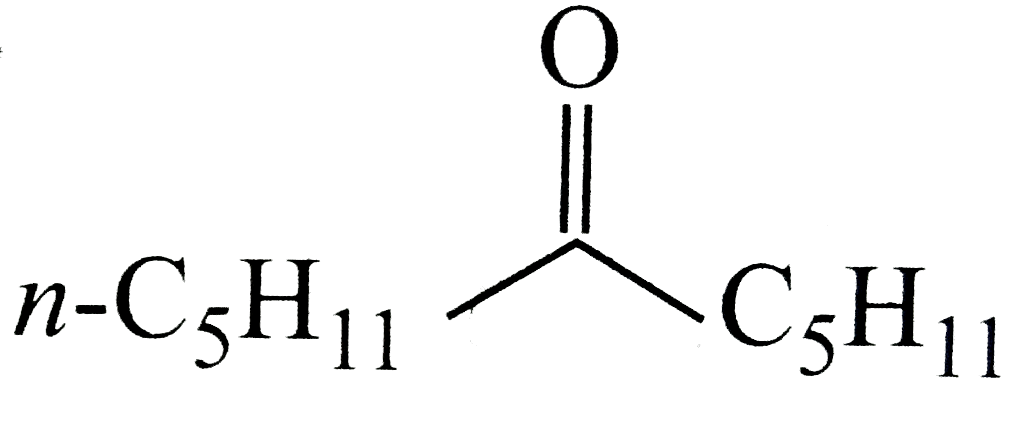Which of the following reactions would give caproic acid ?
A
n−C5H11Br(i)Mg/ether−−−−−−−−→(ii)CO2
B
n−C5H11Li(i)CO2−−−−→(ii)H3O
C
n−C4H9Br(i)Mg/ether−−−−−−−−−−→(i)CO2(iii)H3O⊕
D
n−C5H11MgBr+(CN)2(i)Δ−−−−−−→(ii)H3O⊕
Video Solution
Text Solution
The correct Answer is:A, B
(a,b) The IUPAC name of caproic acid is hexanoic acid (6−C−a→macid). So, G.R must contain 5-X-atom alkyl group.
(a) n−C5H11BrMe/ether−−−−−→n−C5H11Br
(i)CO2−−−−−−→(ii)H3O⊕n−C5H11−COOH.
(b) n−C5H11Li(i)CO2−−−−−→(i)H3O⊕  .
.
( c) Gives pentanoic acid.
n−C5H11MgBr+(CN)2(i)Δ−−−→
 .
.
|
Updated on:21/07/2023
Topper's Solved these Questions
- BOOK - CENGAGE CHEMISTRYCHAPTER - GRIGNARD REAGENTS AND ORGANOMETALLIC REAGENTSEXERCISE - Exercises (Single Correct)47videos
GRIGNARD REAGENTS AND ORGANOMETALLIC REAGENTS
- BOOK - CENGAGE CHEMISTRYCHAPTER - GRIGNARD REAGENTS AND ORGANOMETALLIC REAGENTSEXERCISE - Exercises Archives (Single Correct)4videos
GRIGNARD REAGENTS AND ORGANOMETALLIC REAGENTS
- BOOK - CENGAGE CHEMISTRYCHAPTER - GRIGNARD REAGENTS AND ORGANOMETALLIC REAGENTSEXERCISE - Exercises (Linked Comprehension)33videos
GRIGNARD REAGENTS AND ORGANOMETALLIC REAGENTS
- BOOK - CENGAGE CHEMISTRYCHAPTER - GENERAL PRINCIPLES AND PROCESS OF ISOLATION OF ELEMENTSEXERCISE - Archives (Subjective)14videos
GENERAL PRINCIPLES AND PROCESS OF ISOLATION OF ELEMENTS
- BOOK - CENGAGE CHEMISTRYCHAPTER - NCERT BASED EXERCISEEXERCISE - Nuclear Chemistry (NCERT Exercise)29videos
NCERT BASED EXERCISE
Similar Questions
Knowledge Check
- Question 1 - Select One
The following reaction would give :
 ACH3−CH3∣CH−C∣OCH2CH3H−CH3BCH3−CH3∣C∣OCH2CH3−CH2CH3CCH3−CH2CH3∣C∣OCH2CH3−CH3DAll of the above
ACH3−CH3∣CH−C∣OCH2CH3H−CH3BCH3−CH3∣C∣OCH2CH3−CH2CH3CCH3−CH2CH3∣C∣OCH2CH3−CH3DAll of the above - Question 2 - Select One or More
Which of the following reactions would give propanal ?
AEthyl propanoate + DBAH (diisobutyl aluminium hydride). [(i−C4H9)2AlH)] at −70∘C, followed by hydrolysis.BPropyl propanoate +DIBAL−H/H2OCEthyl cyanide +DBAHDPropanoyl chloride +LBAH - Question 3 - Select One or More
Which of the following reactions will give cinnamic acid?
AC6H5CH=O(CH3CO)2O/CH3COONa−−−−−−−−−−−−−−−−→H3+OBC6H5CH=O(CH3)CH=O/OH−−−−−−−−−−−−−−→H3+OCC6H5CH=O(CH2COOC2H5)2/pyridine−−−−−−−−−−−−−−−−−→H3+ODC6H5COOC2H5=OH3+O−−→
Which of the following reactions would give identical product ?
View SolutionWhich of the following reaction will not give picric acid?
View SolutionWhich of the following reactions would give racemised and retention products ?
View SolutionWhich of the following reactions would give a good yield of hydrocarbon product ?
View SolutionWhich of the following reactions reaction would give propanal?
View Solution

